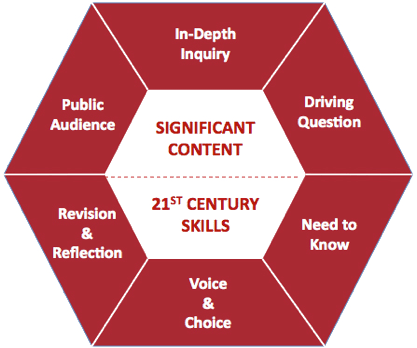
- Significant Content
- Start with identifying your content standards. Ask yourself “what content is reflected on your state test?” and “What is important for your students to understand?” “Would my students find the topic significant?” “How can I make this content relate to my students’ lives and interests?”
- Collaboration
- In Project Based Learning, students utilize team building skills through collaboration. Students assign tasks and plan how they will work together. Students should pause regularly to assess their collaboration skills using rubrics.
- Communication
- Students use rubrics to assess their communication skills. Oral presentations are given at the conclusion of the project. Throughout the project students write down their thinking process which is included in a presentation. Students must ask themselves “Who is my audience?” and “What is the best way to present my information to this type of audience?”
- Critical Thinking
- Strengthening critical thinking skills in students will benefit them far past their project. This is a skill that is needed to be successful in college and the workforce. Student directed learning enables students to find answers using their own existing knowledge.
- Creativity & Innovation
- Students will find your project to be more meaningful if they play a creative role in the construction and planning of the project itself. This allows students to innovate their processes and truly make their project their own.
- Driving Question
- A good driving question should be proactive, open-ended, complex, and linked to your significant content. Your question should be focused on solving a problem and serve as a reminder to your students why they are doing all these activities.
- Need to Know
- Spark students’ “need to know” with an entry event. For example, watching a video of a beautiful beach which ended with a shot of a sign saying “Beach Closed: Contaminated Water” might spark questions such as “how did the water become contaminated?” and “what levels of pollution constitute contamination?”
- In-Depth-Inquiry
- Students will create a list of detailed questions and discuss how to find the answers to these questions. (Teacher, books, articles, websites, experts, etc.) Answers to old questions could generate new questions and generate their own conclusions. Encourage your students to keep asking questions.
- Voice and Choice
- In project based learning students play an important role in the creation and process of their project. Your students should be able to choose from a variety of end products. (Video, brochure, letter, PowerPoint, etc.)
- Feedback & Revision
- Reviewing and critiquing each other’s work regularly is important for students to do. Provide students with rubrics and examples to aid them through the process. This emphasizes that high-quality products and performances is important
- Public Audience
- Require your students to present their end product to a group of people from outside your classroom. (parents, peers, representatives of the community, businesses, government organizations)
What PBL Looks Like in Practice
This video demonstrates what a classroom looks like during the implementation of the actual lesson once the students are presented with the challenge, but what did the preparation look like before this point in time? Project Based Learning requires a different approach to teaching from what the “traditional” classroom of the past looked like. This change can happen, but it is not a list of simple steps one follows to get there. The transformation includes a change in mindset by not only the classroom teacher, but also the students, the parents, and the community alike.
We at Sam Houston State University’s College of Education are working with our university students & faculty and our K-12 partners to make this transformation. We have found that this process is not linear, is not always easy, and that it sometimes appears “messy”.
In an effort to share with you our experiences and what they look like, we have captured video of our real-life struggles to implement PBL in our classrooms and included them throughout this website. Our hope is that by capturing our experiences at various stages in this process, we will somehow help others recognize that, although not always easy, this transformation is certainly possible.
Our thanks go out to all of the teachers, students, administrators, and community members who are working so diligently to make this happen; and those that have agreed to share with you what this process “looks like”. Special thanks go to our graduate students who spent hours capturing the video and processing them into short, succinct videos that demonstrate the various phases of the process.


